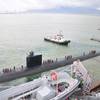In 1992, Kjell Alm developed a method of preventing hard bio fouling from accumulating on surfaces submerged in either the sea or fresh water. The method was designed to be non-toxic and long lasting, and also combines as a corrosion protection coating.
The method uses micro fibers, which through electrostatic application are sprayed onto a surface that is coated with an adhesive. The surface that is then created feels and looks like velvet, and is a surface that the larvae of hard bio fouling are unable to grip onto.
In 1993, Alm patented the method and continued to develop, research and test the product. Today the method has been further refined. The equipment needed has been developed and is manufactured by SealCoat, as are the adhesives blended from solvent free epoxies, which also perform as an excellent anticorrosive.
Results from continual testing on more than 400 vessels proved positive, and Alm began to introduce SealCoat into the market. Today SealCoat operates in 25 countries and the plan is to be, by 2003, present in all strategic marine markets.
At the time SealCoat antifouling product was developed, the need for non-toxic solutions was not a priority. Today, however, with the imminent banning of existing highly poisonous paints, the need to have a cost effective solution is essential. Using a combination of SealCoat fibers, epoxies and an application method, SealCoat is developing a full range of products that are designed to offer excellent levels of protection to all types of surfaces. The main goal of Alm during the early development stages of SealCoat was to produce a product that was both environmentally friendly to the creatures of the deep as well as to the people who need to work with the application of the system.
Featured videos

Inside the Electrified Truckable Tug

Tracking Foreign Vessels Working in the U.S. Jones Act Market

Inmarsat Enhances Service to Drive Digitalization
Subscribe for
Maritime Reporter E-News
Maritime Reporter E-News is the maritime industry's largest circulation and most authoritative ENews Service, delivered to your Email five times per week









